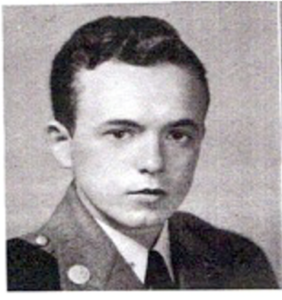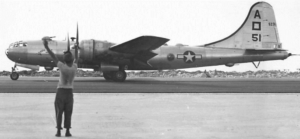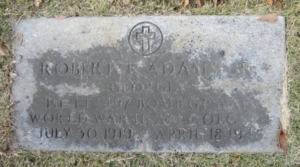Scroll of Honor – Robert Eugene Adams, Jr.
Kamikaze Over Japan
Written by: Kelly Durham
Robert Eugene Adams, Jr. of Atlanta began his collegiate career at North Georgia College in Dahlonega, which like Clemson, was a military school. Unlike Clemson, North Georgia was a two-year institution so Adams crossed the state line to complete a degree in civil engineering. A member of the Class of 1943, Adams was an honor student and was selected for membership in the American Society of Civil Engineers.
After graduation, Adams volunteered for the Army Air Force and was trained as a flight engineer on America’s newest, most technologically complex, and most expensive weapon, the very heavy B-29 Superfortress bomber. The B-29 had been hurriedly developed to meet the demands of the Pacific War, particularly the extremely long range that Air Force planners determined would be needed to bomb Japan’s home islands. Compared with the venerable B-17, the Air Force’s workhorse heavy bomber in Europe with its range of 2,000 miles and 4,500 pound bomb load, the B-29 could travel 3,250 miles and carry 12,000 pounds of bombs—and at higher altitudes and cruising speeds. The B-29’s superlative specifications came with a cost: the aircraft was accident prone and its engines were subject to catastrophic failures. As flight engineer, Adams’s duties included inflight management of the aircraft’s four temperamental 2200-horsepower Wright 3350 engines.
The importance of realizing a quick return on the three billion dollars invested in the B-29 prompted General Hap Arnold, the chief of the Army Air Force, to insist that control of the new bombers be retained at the strategic level. Rather than operating as an air arm of Admiral Chester Nimitz’s central Pacific forces, the B-29s were assigned to the newly created Twentieth Air Force commanded by Arnold and the Joint Chiefs of Staff, completely independent of other commands and dedicated exclusively to the attack of strategic targets in Japan.
The Marianna Islands, just 1,300 miles from Japan, were the objectives of Nimitz’s summer offensive in 1944. Once captured, air bases were quickly established on the islands, including Isley Field on Saipan. Robert Adams and his 497th Bomb Group deployed to the Pacific in September, but before they could begin flying missions, the group had to participate in constructing the Quonset hut facilities needed to sustain their operations. The 497th’s initial combat missions were October attacks against Iwo Jima and the Truk Islands. It’s first attack on Japan came on November 24.
Weather conditions frustrated the B-29s in their efforts to accurately bomb aircraft production factories and other key facilities. Winter clouds and the high winds of what came to be known as the Jet Stream prevented the B-29s from causing the damage Air Force leaders expected from their expensive new weapon.
The arrival of a new commanding officer, Major General Curtis LeMay, ushered in a change of tactics. LeMay ditched the high altitude, daylight pinpoint bombing tactics in favor of low altitude, nighttime area bombing. Rather than blowing up aircraft production plants, the B-29s switched to burning down Japan’s cities.

Gonna Mak’er takes off from Saipan 1944.
On April 18, 1945, Adams was the flight engineer on Gonna Mak’er, a B-29 piloted by First Lieutenant Robert Anderson. Gonna Mak’er departed Isley Field as part of a one hundred twelve bomber formation ordered to attack Japanese air bases on Honshu and Kyushu. The battle on Okinawa was raging, and kamikaze aircraft had been causing severe damage and high casualties among the Navy fleet supporting the ground operations there. The B-29s were about to learn that kamikaze attacks were not reserved for naval ships.
Lieutenant Mosaburo Yamamoto was the commander of a group of Japanese aircraft sent aloft to intercept the B-29s. Rather than engage the fast-flying, well-armed bombers in dogfights, Yamamoto’s airplanes were ordered to ram the larger aircraft. Yamamoto singled out Gonna Mak’er and approached from two o’clock, making a high pass at the bomber. The B-29’s right gunner fired a long burst into the fighter, striking it as it began a turn. On its second pass, the fighter rammed into Gonna Mak’er, snapping off the bomber’s right wing and tail. Without aerodynamic control, the bomber began spinning and tumbling, trapping its crew inside. No parachutes were observed and the bomber crashed at Ogori in Fukuoka Prefecture killing all aboard.
After the war, Adams’s remains were returned to Georgia and buried in the Decatur Cemetery.
For more information on Robert Eugene Adams, Jr. see:
https://soh.alumni.clemson.edu/scroll/robert-eugene-adams-jr/
For additional information about Clemson University’s Scroll of Honor visit:
https://soh.alumni.clemson.edu/
